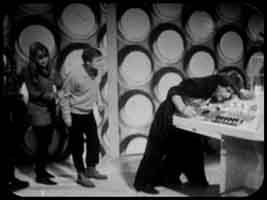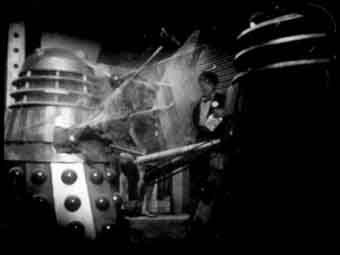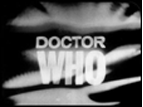|
Anthony
Clark examines how the produces of Dr Who managed to
change the show's leading man for the first time without damaging
its popularity...
William
Hartnell was no longer to play the Doctor because of a mix
of illness and production team dislike - he was proving 'difficult'
and sometimes near impossible to work with, partly due to
his failing health. For most successful shows losing your
hero would have spelt the end: no leading man, no programme.
But for Dr Who a solution was suggested - just change
the actor. And as simple as the idea now sounds, it was nothing
short of revolutionary in its concept as envisaged for the
mystery time traveller. The actor would change, his character
would change, but the Doctor would basically remain the same
person. But how would the public react to the new face in
the TARDIS?
 |
The
BBC chose Patrick Troughton, TV's first Robin Hood, to take
over the role but it soon became clear that the actor and
production team were finding it difficult to choose him a
persona. "Pat was clearly getting frustrated by the process,"
said Gerry Davis, the show's script editor. "We'd talked over
a number of ideas but it was becoming increasingly obvious
that we were losing him. So I cleared the meeting and suggested
that Pat play himself.
"I'd
noticed how Pat could be very fey, often avoiding giving a
straight answer," explained Davis. "He reminded me of Jimmy
Stuart in Destry Rides Again. When asked why he doesn't carry
a gun Stuart says that they're dangerous, 'someone could get
hurt', and I saw the Doctor very much in the mould.
"Maintaining
the character proved very difficult for the writers and he
slowly lost that air of other-world mystery, which I think
was a shame," said Davis. "But Pat was very good, very easy
to work with."
The
Doctor's new appearance was built from the idea from the BBC's
head of drama, Sydney Newman, who suggesting Troughton play
the Doctor as a "cosmic hobo". And although the idea was fine-tuned
by the wardrobe department over the first few stories - the
trousers were taken in and the stovepipe hat disappeared -
the basic down-at-heel look survived.
But
how to introduce the new Doctor to an audience fond of a white-haired
and rather crotchety older Doctor? The only sensible answer
was a Dalek story as show's most popular alien menace always
added viewing figures. Perhaps a blitz of Dalek menace could
help ease the new Doctor into the TARDIS while viewers were
swept along by an exterminating tide of terror.
 |
David
Whitaker, who had been Doctor Who's story editor during
Season One, was commissioned to write The Destiny Of Doctor
Who. He finished a first draft but could do no more work
on it due to other commitments. Davis was occupied with other
Doctor Who work and so turned to another former script
editor, Dennis Spooner, to perform the much-needed revisions
on the story, which had by this time gained the new title
The Power Of The Daleks. Because little had been decided
about the new Doctor's character, Whitaker had largely written
his drafts for a generic Doctor; to make matters worse, the
scripts were overlong and badly needed tightening up. Spooner
performed the needed revisions, including tailoring the scripts
to fit the character of Troughton's Doctor from notes by Davis.
To
the relief of everyone concerned - lot least Troughton himself
- the new Doctor quickly settled in to the TARDIS, setting
a president that helped the mystery Time Lord change his face
several more times before the show's final demise. Strangely,
no other TV programme has tried to repeat the trick.

Return
to...

|